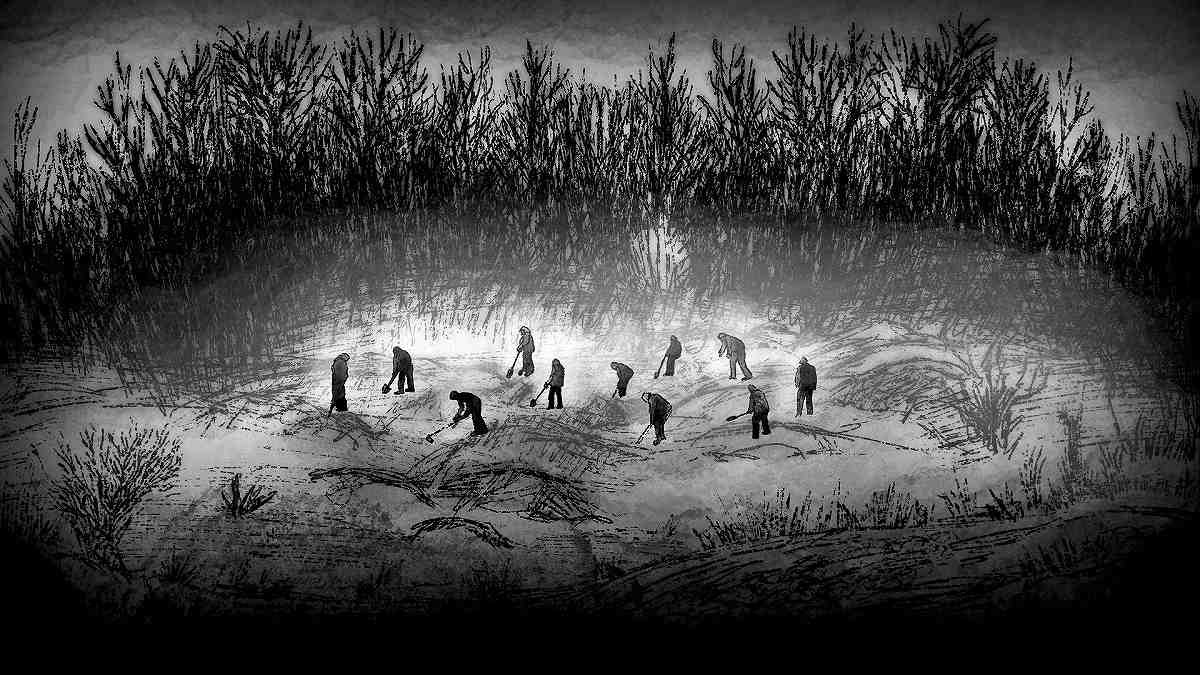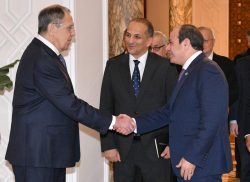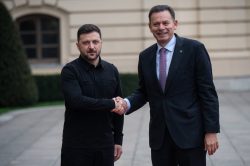Thousands of Ukraine Civilians Are Being Held in Russian Prisons. Russia Plans to Build Many More

Illustration of detained Ukrainian civilians digging into frozen ground.
15:25 JST, July 14, 2023
ZAPORIZHZHIA, Ukraine (AP) — The Ukrainian civilians woke long before dawn in the bitter cold, lined up for the single toilet and were loaded at gunpoint into the livestock trailer. They spent the next 12 hours or more digging trenches on the front lines for Russian soldiers.
Many were forced to wear overlarge Russian military uniforms that could make them a target, and a former city administrator trudged around in boots five sizes too big. By the end of the day, their hands curled into icy claws.
Nearby, in the occupied region of Zaporizhzhia, other Ukrainian civilians dug mass graves into the frozen ground for fellow prisoners who had not survived. One man who refused to dig was shot on the spot — yet another body for the grave.
Thousands of Ukrainian civilians are being detained across Russia and the Ukrainian territories it occupies, in centers ranging from brand-new wings in Russian prisons to clammy basements. Most have no status under Russian law.
And Russia is planning to hold possibly thousands more. A Russian government document obtained by The Associated Press dating to January outlined plans to create 25 new prison colonies and six other detention centers in occupied Ukraine by 2026.
In addition, Russian President Vladimir Putin signed a decree in May allowing Russia to send people from territories with martial law, which includes all of occupied Ukraine, to those without, such as Russia. This makes it easier to deport Ukrainians who resist Russian occupation deep into Russia indefinitely, which has happened in multiple cases documented by the AP.
Many civilians are picked up for alleged transgressions as minor as speaking Ukrainian or simply being a young man in an occupied region, and are often held without charge. Others are charged as terrorists, combatants, or people who “resist the special military operation.” Hundreds are used for slave labor by Russia’s military, for digging trenches and other fortifications, as well as mass graves.
Torture is routine, including repeated electrical shocks, beatings that crack skulls and fracture ribs, and simulated suffocation. Many former prisoners told the AP they witnessed deaths. A United Nations report from late June documented 77 summary executions of civilian captives and the death of one man due to torture.
Russia does not acknowledge holding civilians at all, let alone its reasons for doing so. But the prisoners serve as future bargaining chips in exchanges for Russian soldiers, and the U.N. has said there is evidence of civilians being used as human shields near the front lines.
The AP spoke with dozens of people, including 20 former detainees, along with ex-prisoners of war, the families of more than a dozen civilians in detention, two Ukrainian intelligence officials and a government negotiator. Their accounts, as well as satellite imagery, social media, government documents and copies of letters delivered by the Red Cross, confirm a widescale Russian system of detention and abuse of civilians that stands in direct violation of the Geneva Conventions.
Some civilians were held for days or weeks, while others have vanished for well over a year. Nearly everyone freed said they experienced or witnessed torture, and most described being shifted from one place to another without explanation.
“It’s a business of human trafficking,” said Olena Yahupova, the city administrator who was forced to dig trenches for the Russians in Zaporizhzhia. “If we don’t talk about it and keep silent, then tomorrow anyone can be there — my neighbor, acquaintance, child.”
INVISIBLE PRISONERS
The new building in the compound of Prison Colony No. 2 is at least two stories tall, separated from the main prison by a thick wall.
This facility in Russia’s eastern Rostov region has gone up since the war started in February 2022, according to satellite imagery analyzed by the AP. It could easily house the hundreds of Ukrainian civilians who are believed detained there, according to former captives, families of the missing, human rights activists and Russian lawyers. Two exiled Russian human rights advocates said it is heavily guarded by soldiers and armored vehicles.
The building in Rostov is one of at least 40 detention facilities in Russia and Belarus, and 63 makeshift and formal in occupied Ukrainian territory where Ukrainian civilians are held, according to an AP map built on data from former captives, the Ukrainian Media Initiative for Human Rights, and the Russian human rights group Gulagu.net. The recent U.N. report counted a total of 37 facilities in Russia and Belarus and 125 in occupied Ukraine.
Some also hold Russian prisoners accused or convicted of a variety of crimes. Other, more makeshift locations are near the front lines, and the AP documented two locations where former prisoners say Ukrainians were forced to dig trenches.
The shadowy nature of the system makes it difficult to know exactly how many civilians are being detained. Ukraine’s government has been able to confirm legal details of a little over 1,000 who are facing charges.
At least 4,000 civilians are held in Russia and at least as many scattered around the occupied territories, according to Vladimir Osechkin, an exiled Russian human rights activist who talks to informants within Russian prisons and founded Gulagu.net to document abuses. Osechkin showed AP a Russian prison document from 2022 saying that 119 people ‘‘opposed to the special military operation’’ in Ukraine were moved by plane to the main prison colony in the Russian region of Voronezh. Many Ukrainians later freed by Russia also described unexplained plane transfers.
In all, Ukraine’s government believes around 10,000 civilians could be detained, according to Ukrainian negotiator Oleksandr Kononeko, based on reports from loved ones, as well as post-release interviews with some civilians and the hundreds of Ukrainian soldiers returned in prisoner exchanges. Ukraine said in June that about 150 civilians have been freed to Ukrainian-controlled territory, and the Russians deny holding others.
“They say, ‘We don’t have these people, it’s you who is lying,’” Kononeko said.
The detention of two men from the Kherson region in August 2022 offers a glimpse at how hard it is for families to track down loved ones in Russian custody.
Artem Baranov, a security guard, and Yevhen Pryshliak, who worked at a local asphalt plant with his father, had been friends for over a decade. Their relationship was cemented when both bought dogs during the coronavirus pandemic, according to Baranov’s common-law wife, Ilona Slyva. Their evening walks continued even after Russia seized their hometown of Nova Kakhovka — shy Baranov with a giant black Italian mastiff and Pryshliak with a toy poodle whose apricot fur matched his beard.
Their walk ran late the night of Aug. 15, and Pryshliak decided to stay at Baranov’s apartment rather than risk being caught breaking the Russian curfew. Neighbors later told the family that 15 armed Russian soldiers swooped in, ransacked the apartment and seized the men.
For a month, they were in the local jail, with conditions relaxed enough that Slyva was able to talk to Pryshliak through the fence. Baranov, he told her, couldn’t come out.
She sent in packages of food and clothes but did not know if they were reaching him. Finally, on Baranov’s birthday, she bought his favorite dessert of cream eclairs, smashed them up, and slipped in a scrap of paper with her new Russian phone number scrawled on it. She hoped the guards would have little interest in the sticky mess and just pass it along.
A month went by, and the families learned the men had been transferred to a new prison in Sevastopol, in Crimea. Then the trail went dark.
Four more months passed. Then a call came from the family of a man they had never met but would soon come to know well: Pavlo Zaporozhets.
Zaporozhets, a Ukrainian from the occupied Kherson region charged with international terrorism, was sharing a cell in Rostov with Baranov. Since he faced charges, he had a lawyer.
It was then that Slyva knew her gift of eclairs — and the phone number smuggled within them — had reached its destination. Baranov had memorized her number and passed it through a complex chain that finally got news of him to her on April 7.
Baranov wrote that he was accused of espionage — an accusation that Slyva scorned as falling apart even under Russia’s internal logic. He was detained in August, and Russia illegally annexed the regions only in October.
“When he was detained, he was on his own national territory,” she said. “They thought and thought and invented a criminal case against him for espionage.”
Baranov wrote home that he was transported across prisons with his eyes closed in two planes, one of which had about 60 people. He and Pryshliak were separated at their third transfer in late winter. Pryshliak’s family has received a form letter from the Rostov prison denying he is an inmate there.
The number of civilian detainees has grown rapidly over the course of the war. In the first wave early on, Russian units moved in with lists of activists, pro-Ukrainian community leaders, and military veterans. Melitopol Mayor Ivan Fedorov was taken when Russian forces seized control of his city but exchanged within a week for nine Russian soldiers, he said.
Then they focused on teachers and doctors who refused to work with the occupation authorities. But the reasons for apprehending people today are as mundane as tying a ribbon to a bicycle in the Ukrainian colors of blue and yellow.
“Now there is no logic,” Fedorov said.
He estimated that around 500 Ukrainian civilians are detained just in his city at any time — numbers echoed by multiple people interviewed by the AP.
A Ukrainian intelligence official said the Russian fear of dissidents had become “pathological” since last fall, as Russians brace for Ukraine’s counteroffensive. The official spoke on condition of anonymity to discuss the situation.
The AP saw multiple missing person notices posted on closed Ukrainian social media chats for young men seized off the streets. The messages, written in Ukrainian, describe detentions at gunpoint at home and on the street, with pleas to send information and emojis of hearts and praying hands.
The Geneva Conventions in general forbid the arbitrary detention or forced deportation of civilians, and state that detainees must be allowed to communicate with loved ones, obtain legal counsel and challenge allegations against them. But first they must be found.
After months writing letter after letter to locate Pryshliak, his sister-in-law Liubov thinks she knows why the prisoners are moved around: “So that the families cannot find them. Just to hide the traces of crimes.”
SLAVES IN THE TRENCHES
Hundreds of civilians end up in a place that is possibly even more dangerous than the prisons: the trenches of occupied Ukraine.
There, they are forced to build protection for Russian soldiers, according to multiple people who managed to leave Russian custody. Among them was Yahupova, the 50-year-old civil administrator detained in October 2022 in the Zaporizhzhia region, possibly because she is married to a Ukrainian soldier.
Under international humanitarian law, Yahupova is a civilian — defined as anyone who is not an active member of or volunteer for the armed forces. Documented breaches of the law constitute a war crime and, if widespread and systematic, “may also constitute a crime against humanity.”
But the distinctions between soldiers and civilians can be hard to prove in a war where Ukraine has urged all its citizens to help, for example by sending Russian troop locations via social media. In practice, the Russians are scooping up civilians along with soldiers, including those denounced by neighbors for whatever reason or seized seemingly at random.
They picked Yahupova up at her house in October. Then they demanded she reveal information about her husband, taping a plastic bag over her face, beating her on the head with a filled water bottle and tightening a cable around her neck.
They also dragged her out of the cell and drove her around town to identify pro-Ukrainian locals. She didn’t.
When they hauled her out a second time, she was exhausted. As a soldier placed her in front of a Russian news camera, she could still feel the dried blood on the back of her neck. She was going to give an interview, her captors told her.
Behind the camera, a gun was pointed at her head. The soldier holding it told her that if she gave the right answers to the Russian journalist interviewing her, she could go free.
But she didn’t know what the right answers were. She went back to the cell.
Three months later, without explanation, Yahupova was again pulled outside. This time, she was driven to a deserted checkpoint, where yet another Russian news crew awaited. She was ordered to hold hands with two men and walk about 5 meters (yards) toward Ukraine.
The three Ukrainians were ordered to do another take. And another, to show that Russia was freeing the Ukrainian civilians in its custody.
Except, at the end of the last take, Russian soldiers loaded them into a truck and drove them to a nearby crossroads. One put shovels into their hands.
“Now you will do something for the good of the Russian Federation,” he said.
And so Yahupova ended up digging trenches until mid-March with more than a dozen Ukrainian civilians, including business owners, a student, a teacher, and utility workers. She could see other crews in the distance, with armed guards standing over them. Most wore Russian military uniforms and boots, and lived in fear that Ukrainian artillery would mistake them for the enemy.
The AP confirmed through satellite imagery the new trenches dug in the area where Yahupova and a man on the Ukrainian crew with her said they were held. He requested anonymity because his relatives still live under occupation.
“Sometimes we even worked there 24 hours a day, when they had an inspection coming,” he said.
The man also spoke with other Ukrainian civilians digging mass graves nearby for at least 15 people. He said one civilian had been shot for refusing to dig. Satellite imagery shows a mound of freshly-dug earth in the spot the man described.
The man escaped during a Russian troop rotation, and Yahupova also made her way out. But both said hundreds of others are still in the occupied front lines, forced to work for Russia or die.
When Yahupova returned to her home after more than five months, everything had been stolen. Her beloved dog had been shot. Her head ached, her vision was blurred, and her children — long since out of the occupied territories — urged her to leave.
She traveled thousands of miles through Russia, north to the Baltics and back around to the front line in Ukraine, where she reunited with her husband serving with Ukrainian forces. Earlier married in a civil ceremony, the two got wed this time in church.
Now safe in Ukrainian territory, Yahupova wants to testify against Russia — for the months it stole from her, the concussion that troubles her, the home she has lost. She still reflexively touches the back of her head, where the bottle struck her over and over.
“They stole not only from me, they stole from half the country,” she said.
TORTURE AS POLICY
The abuse Yahupova described is common. Torture was a constant, whether or not there was information to extract, according to every former detainee interviewed by the AP. The U.N. report from June said 91% of prisoners “described torture and ill-treatment.”
In the occupied territories, all the freed civilians interviewed by the AP described crammed rooms and cells, tools of torture prepared in advance, tape placed carefully next to office chairs to bind arms and legs, and repeated questioning by Russian’s FSB intelligence agency. Nearly 100 evidence photos obtained by the AP from Ukrainian investigators also showed instruments of torture found in liberated areas of Kherson, Kyiv and Kharkiv, including the same tools repeatedly described by former civilian captives held in Russia and occupied regions.
Many former detainees spoke of wires linking prisoners’ bodies to electricity in field telephones or radios or batteries, in a procedure one man said the Russians dubbed “call your mother” or “call Biden.” U.N. human rights investigators said one victim described the same treatment given to Yahupova, a severe beating on the head with a filled water bottle.
Viktoriia Andrusha, an elementary school math teacher, was seized by Russian forces on March 25, 2022, after they ransacked her parents’ home in Chernihiv and found photos of Russian military vehicles on her phone. By March 28, she was in a prison in Russia. Her captors told her Ukraine had fallen and no one wanted any civilians back.
For her, like so many others, torture came in the form of fists, batons of metal, wood and rubber, plastic bags. Men in black, with special forces chevrons on their sleeves, pummeled her in the prison corridor and in a ceramic-tiled room seemingly designed for quick cleaning. Russian propaganda played on a television above her.
“There was a point when I was already sitting and saying: Honestly, do what you want with me. I just don’t care anymore,” Andrusha said.
Along with the physical torture came mental anguish. Andrusha was told repeatedly that she would die in prison in Russia, that they would slash her with knives until she was unrecognizable, that her government cared nothing about a captive schoolteacher, that her family had forgotten her, that her language was useless. They forced captives to memorize verse after verse of the Russian national anthem and other patriotic songs.
“Their job was to influence us psychologically, to show us that we are not human,” she said. “Our task was to make sure that everything they did to us did not affect us.”
Then one day, without explanation, it was over for her and another woman kept with her. Guards ordered them to pack up, cuffed them and put them in a bus. The weight Andrusha had lost in prison showed starkly in the cast-off jacket that hung from her shoulders.
They were soon joined by Ukrainian soldiers held captive elsewhere. On the other side, Andrusha saw three Russian soldiers. Although international law forbids the exchange of civilians as prisoners of war, the U.N. report on June 27 said this has happened in at least 53 cases, and Melitopol Mayor Fedorov confirmed it happened to him.
A man detained with Andrusha in March 2022 is in captivity still. She doesn’t know the fate of the others she met. But many former captives take it upon themselves to contact the loved ones of their former cellmates.
Andrusha recalled hours spent memorizing whispered phone numbers in a circle with other Ukrainians, on the chance one of them might get out. When she was freed, she passed them along to Ukrainian government officials.
Andrusha has since regained some of her weight. She talks about her six months in prison calmly but with anger.
“I was able to survive this,” she said, after a day back in the classroom with her students. “There are so many cases when people do not return.”
In the meantime, for loved ones, the wait is agony.
Anna Vuiko’s father was one of the earliest civilians detained, in March last year. A former glass factory worker on disability, Roman Vuiko had resisted when Russian soldiers tried to take over his home in suburban Kyiv, neighbors told his adult daughter. They drove a military truck into the yard, shattered the windows, cuffed the 50-year-old man and drove off.
By May 2022, Vuiko was in a prison in Kursk, Russia, hundreds of kilometers (miles) away. All his daughter has gotten from him since is a handwritten letter, which arrived six months after he was taken away and four months after he wrote it. The standard phrases told his daughter nothing except that he was alive, and she suspects he has not received any of her letters.
“I think about it every day,” she said. “It’s been a year, more than a year. … How much more time has to pass?”
"News Services" POPULAR ARTICLE
-

American Playwright Jeremy O. Harris Arrested in Japan on Alleged Drug Smuggling
-

Japan’s Nikkei Stock Average as JGB Yields, Yen Rise on Rate-Hike Bets
-

Japan’s Nikkei Stock Average Licks Wounds after Selloff Sparked by BOJ Hike Bets (UPDATE 1)
-

Japanese Bond Yields Zoom, Stocks Slide as Rate Hike Looms
-

Japan’s Nikkei Stock Average Buoyed by Stable Yen; SoftBank’s Slide Caps Gains (UPDATE 1)
JN ACCESS RANKING
-

Keidanren Chairman Yoshinobu Tsutsui Visits Kashiwazaki-Kariwa Nuclear Power Plant; Inspects New Emergency Safety System
-

Imports of Rare Earths from China Facing Delays, May Be Caused by Deterioration of Japan-China Relations
-

University of Tokyo Professor Discusses Japanese Economic Security in Interview Ahead of Forum
-

Japan Pulls out of Vietnam Nuclear Project, Complicating Hanoi’s Power Plans
-

Govt Aims to Expand NISA Program Lineup, Abolish Age Restriction


























